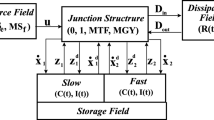Abstract
A particular class of nonlinear singularly perturbed systems by using a bond graph approach is proposed. The class of nonlinear systems is defined by terms of product of state variables whose bond graph representation is described by MTF or MGY elements modulated by state variables. The singular pertubations applied to the system permit the separation of time scales. When the assumptions of Tikhonov Theorem are satisfied, then a new bond graph called singularly perturbed nonlinear bond graph (SPNBG) to determine the quasi-steady-state model of the system is presented. The SPNBG is characterized by having an integral causality assignment for the storage elements that represent the slow dynamics, and the storage elements of the fast dynamics have a derivative causality assignment. Finally, the proposed methodology is applied to an illustrative example.






Similar content being viewed by others
References
Saksena VR, O’Reilly J, Kokotovich P (1984) Singular perturbations and time-scale methods in control theory: survey 1976–1983. Automatica 20(3):273–293
Subbaram Naidu D, Calise AJ (2001) Singular perturbations and time scales in guidance and control of aerospace systems: a survey, Journal of Guidance Control. Dynamics 24(6):1057–1078
Kokotovic PV, Khalil HK, O’Reilly J (1986) Singular perturbation methods in control: analysis and design. Academic Press, London
Khalil HK (2002) Nonlinear systems. Prentice Hall, Upper Saddle River
Pekarek SD, Lemanski MT, Walters EA (2002) On the use of singular perturbations to neglect the dynamic saliency of synchronous machines. IEEE Trans Energy Conver 17(3):385–391
Chow JH, Winkelman JR, Pai MA, Saver PW (1984) Singular perturbations and time-scales methods in control theory: survey 1976–1983. Automatica 20(3):273–293
Karnopp Dean C, Margolis Donald L, Rosenberg Ronald C (2000) System dynamics modeling and simulation of mechatronic systems. Wiley, Hoboken
Brown FT (2001) Engineering System Dynamics. Marcel Dekker Inc., New York
Sueur C, Dauphin-Tanguy G (1991) Bond graph approach to multi-time systems analysis. J Frankl Inst 328(5/6):1005–1026
Dauphin-Tanguy G, Borne P, Lebrun M (1985) Order reduction of multi-time scale systems using bond graphs, the reciprocal system and the singular perturbation method. J Frankl Inst 319(1/2):157–171
Orbak AY, Turkay OS, Eskimat E, Youcef-Toumi K (2003) Model Reduction in the physical domain. Proc Inst Mech Eng Part I: J Syst Control Eng 217:481–496
Gonzalez G, Galindo R (2009) Steady state determination using bond graphs for systems with singular state matrix. In: Proceedings of the Institution of Mechanical Engineers Part I: Journal of Systems and Control Engineering
Gilberto Gonzalez A, Noe Barrera G (2013) Quasi-steady state model determination for systems with singular perturbations modelled by bond graphs. Math Comput Model Dyn Syst Methods Tools Appl Eng Related Sci. doi:10.1080/13873954.2013.766214
Tikhonov AN (1952) Systems of differential equations contianing a small parameter multiplying the derivative. Mat Sb 31:575–586
Levinson N (1950) Perturbations of discontinuous solutions of non-linear systems of differential equations. Acta Math 82:71–106
Vasil’eva AB (1976) Singularly perturbed systems with an indeterminacy in their degenerate equations. J Differ Equ 12:1227–1235
Wasow W (1965) Asymptotic expansions for ordinary differential equations. Wiley, New York
Malley RE (1972) The singularly perturbed linear state regulator problem. SIAM J Control 10:399–413
Author information
Authors and Affiliations
Corresponding author
Rights and permissions
About this article
Cite this article
Gonzalez-Avalos, G., Padilla, J.A. Quasi-steady-state model of a class of nonlinear singularly perturbed system in a bond graph approach. Electr Eng 100, 293–302 (2018). https://doi.org/10.1007/s00202-016-0507-x
Received:
Accepted:
Published:
Issue Date:
DOI: https://doi.org/10.1007/s00202-016-0507-x




